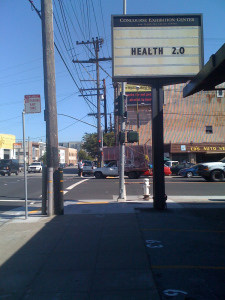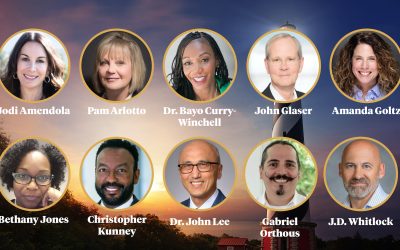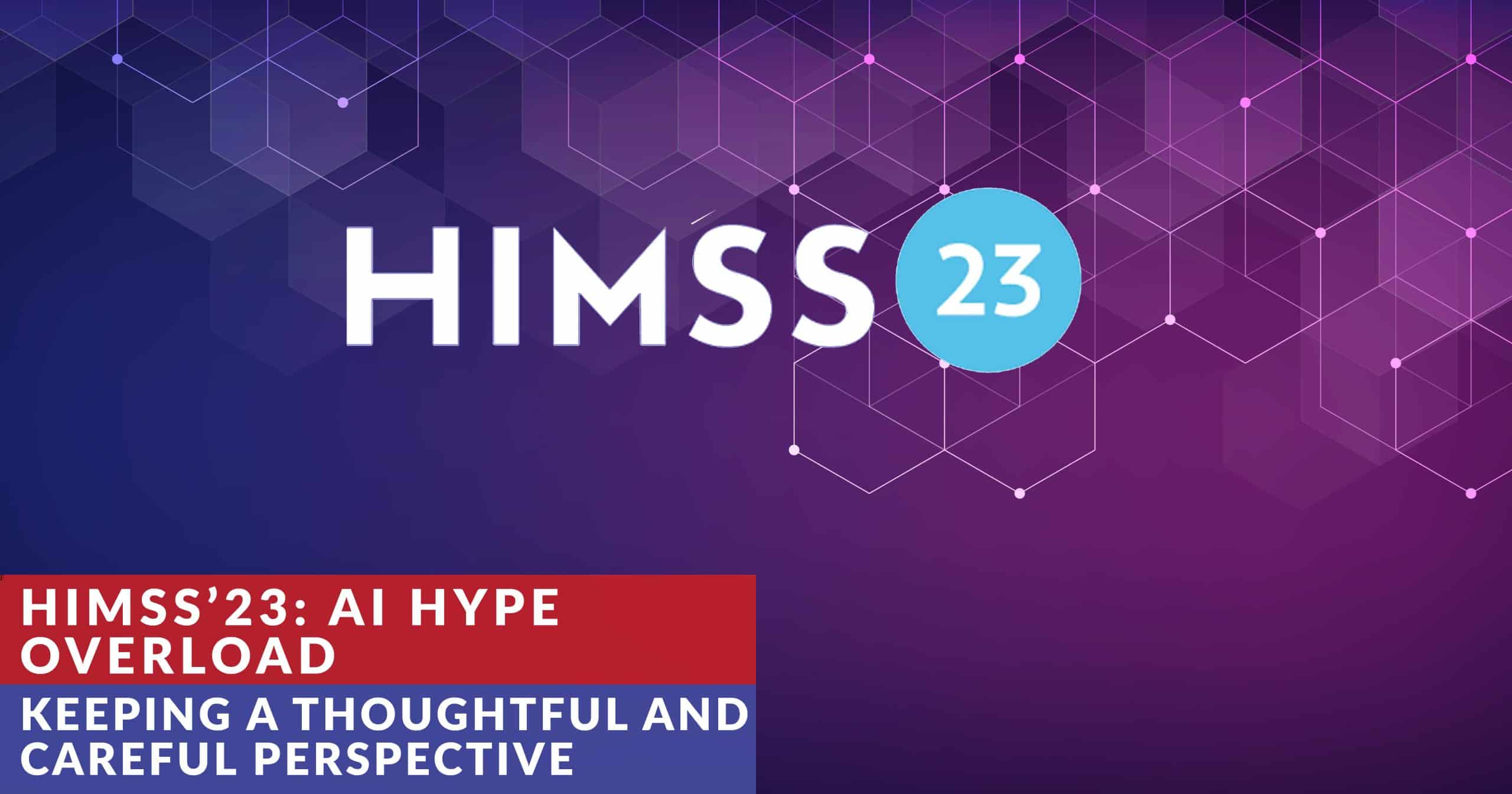 Another Health 2.0 Conference has come to pass and with broken wrist limiting typing fluidity, going to keep this synopsis short and sweet.
Another Health 2.0 Conference has come to pass and with broken wrist limiting typing fluidity, going to keep this synopsis short and sweet.
Not sure who said first impressions are lasting impressions, but coming up on the facilities that were to house this year’s Health 2.0 conference, I had a moment of trepidation upon seeing the signage for Health 2.0 (yes, the picture to right is real) with a back-drop of a funky auto parts and repair store across the street. Once in the cavernous hall (note to self – cavernous halls should not concurrently house exhibits and stage) all went smoothly until one opened up the laptop and alas, no Wi-fi (actually there ended up being sporadic service but it was so bad as to be almost worthless). An event focusing on Internet tools for health and no Wi-fi – am I in some sort of perverse David Lynch movie?
On to the event itself…
Highlights:
The Health 2.0 Accelerator demonstration was pretty impressive. In the demonstration, nine different applications were used in a fairly seamless fashion to facilitate a consumer’s interaction with the healthcare system. A simple, yet powerful demonstration of what is possible when independent software vendors (ISVs) agree on some basic open standards, in this case OAuth and CCR to securely move data around a network. This example, while still a little too cumbersome or most consumers, points us in the right direction and might make an ideal case for the Health Internet.
Ability to meet many innovators in one place. Health 2.0 is really the only game in town today that draws a wide range of innovators to one location. J.D. Kleinke wrote a very good post on the event where he thought maybe the event was becoming a little too corporate. I really do not see much problem with that, in fact, would like to see more realism demonstrated by these innovators through their articulation of clear and compelling business models, but I digress.
Best Demo: A tie, HealthVault & Quicken Health are the hands-down winners for best demos (outside of the Accelerator mentioned above). HealthVault demonstrated their new “widget store” that is available within one’s personal MSN Health & Wellness account. Leveraging data that one has in their HealthVault account, the MSN health widgets make that data truly actionable. Over time, one can envision a health “AppStore” in MSN Health quite similar to Apple’s AppStore for the iPhone where ISVs build a wide range of health apps for the consumer that can be readily accessed all in one place.
While I have always had reservations about Quicken Health (too limited, only addresses one problem, financial) was very impressed with the architecture of the application. Beautiful user interface, very nice tools built right in (e.g. hover over a given lab and you get a brief abstract of the lab test and its purpose). Another nice feature was the ability to contest claims, electronically, right from within Quicken. Having dealt with many a mis-labeled/assessed claim before, that feature alone (no more voicemail hell) practically sold me on getting this app when it is released later this year. Upon further thought though, better check with my payer first to see if they even would allow me to contest a claim electronically.
Excellent briefings with several companies including an update with Google Health, a deep and thoughtful dive with Within3 (keep track of them, they may have something if they move fast enough), a good update from Allviant (product CarePass is in beta), a great conversation, as always, with the folks of Polka and a surprising interview (amazed at how far they have come, more in near future) with MedHelp (another one to watch).
Disappointments:
While the Health 2.0 Accelerator succeeded, the Clinical Groupware session failed. First off, I am not sure those in the audience fully understood what the term “clinical groupware” means and why it is important to consider. Second, there was almost no discussion on what type of underlying architecture is required to make apps run in a clinical groupware environment. So what we were left with was some very broad statements that clinical groupware is good for you, good for the industry, etc. but nothing about how it would actually work. Then there were the vendors in this session that did little to further the discussion. Instead of demonstrating data sharing and substitutability of their apps, key tenets for clinical groupware to work, we were shown apps working in isolation.
Payers certainly have a voice in the healthcare discussion but do they really have a voice in the Health 2.0 discussion. Certainly the organizers of this event think so but I differ. Ultimately, it is employers that are footing the bill and have the most to potentially gain in offering their employees such tools. And if not employers, how about the benefits consultants who advise them? Getting quite tired of sessions composed of payers talking about how they always want to do good for their members. Let’s be real, they want to maintain and/or improve margins and few consumers trust them.
The apparent fawning over the latest Health 2.0 rock star(s). At the Spring event it was Jay Parkinson and Hello Health. This fall it appeared that we had two: Roy Schoenberg of American Well and Adam Bosworth of Keas. I’ll give credit to American Well to at least having a product/service in the market, but do they really need to be placed on a pedestal as the poster child for telemedicine? Roy is extremely polished and presents well, but hey, they are far from being the only game in town and not sure why they had two separate stage apearances, one on each day. As for Adam and Keas, Adam certainly has a great publicist (gets an article on Keas in the NY Times on the first day of Health 2.0, coincidence, I doubt it) and is well known in IT circles, but he has also been extremely slow in introducing his product – suppose to go GA sometime this month. So here we have a company founder without a live product in the market again being invited up on stage on two separate occasions. Why, I can’t figure it out as my initial assessment of Keas is that it is a fairly simple product with low barriers for competing products (e.g., if Google put their mind to it, they could do the same with their search features and Google Health pretty easily).
The venue was just a disaster, enuf said.
Where are the established HIT companies, where are the intersections between these traditional ISVs that ultimately hold the data and these Health 2.0 ISVs looking to get their hands on it to power their services. Bridges need to be built as today, Health 2.0 sits like an island, isolated in a very broad sea.
Wrap-up:
Health 2.0 is a great networking event. Just about everyone in this particularly market is there and its always good to connect with people face-to-face as phone calls, emails, etc. only go so far. Content of sessions though is a very mixed bag and appears highly slanted to those vendors who pay to play (sponsors, exhibitors, etc.) and not as expansive as it could be. Hopefully, like many things in life, the organizers of this Fall’s Health 2.0 will learn from the many mistakes made and the next one will bring more value to attendees.




John.
In general this is a pretty decent review, although now you’re a major league blogger & analyst you might want to consider one of these. http://fineurl.com/bh3p And let me remind you that most conferences don’t offer WiFi at all! However, I’ll be saying more about this on THCB and suffice it to say it was very painful for us.
On to your substance. You don’t understand clinical groupware–don’t worry, it’s a new concept and you’ll get there eventually. Failing that David Kibbe will come round and explain it. But that didn’t mean the “demo failed” it meant that you failed to understand what the panel was trying to say. (And I won’t critique your writing but you repeat two sentences saying the same thing). In fact all five demos were illustrating a particular point. These were
–patient form completion–VisionTree;
–information brought it to a clinical encounter from external record–American Well;
–Physician issued careplans-RMD;
— live chat leading to physician charting, Myca/Hello Health
–Data integrated from IHE platform–RelayHealth
And I agree with much about the venue. Happens that there was no where else available in San Francisco at a time that doesn’t clash with several other conferences. And as a side note it enabled us to have much better food as we weren’t locked into the hotel plastic chicken!
And you may be all excited about employers, but that just shows that you’re new to health care–they don’t matter much and never have done. They may in the future but we’re still waiting. You also missed that of the 5 people on that panel 2 were representatives of employers or unions, not health plans.
And if you don’t like American Well and Keas, and don’t think that Adam or Roy they (or Alex Drane or Chris Schroeder) are good interviews to give the sense of what running a new-ish company is like, then we can just agree that you’re wrong 🙂 But the point is they’re second appearance was to talk, their first was to demo. The casual reader of your note might think we were having them demo twice.
And we’d be happy to have big HIT vendors–in fact did you miss Glen Tullman on the last panel? We just dont think they have much to contribute to Health 2.0 yet
But these are all just opinions and we both know that we disagree about them, and that disagreement is healthy.
But you must stop any accusations of pay to play. They’re not true and they’re illogical. Look at your favorites, Quicken Health. 3 times on at Health 2.0–total sponsorship dollars paid $0, despite the fact that I think Intuit could afford it. Look at your new least favorite (Adam Bosworth) Twice on at Health 2.0, sponsorship dollars paid $0. In fact we let his wife in for free (Hi, Neely!). Look at the clinical groupware panel. Two big sponsors, two who didnt sponsor at all. One who bought some water bottles at the last minute. You can look down our sponsor list and find lots of sponsors who didn’t get on stage to demo, yet there were about 60 more demoers who didn’t sponsor.
And just being a sponsor doesn’t mean you’re bad! You liked Within3–yes they sponsored. Sitting next to them was MyPacs.net (part of McKesson) which could surely have afforded a few bucks but didn’t, then there was iGuard, CureTogether, PatientsLikeMe, and the FDA. Not a penny between them. Did Within3 just get on stage because they sponsored? Add if so, how can you be so impressed?
The truth is that like any other conference we have to find both ways to attract attention ) and to pay for the costs of the conference so the press (which we loosely call you because of this blog), and the speakers get in for free. So it’s only natural that the type of Health 2.0 companies that we’re likely to want to show are going to want to market themselves at Health 2.0. But not all of them do it.
What is true is that the sales process for sponsorship and the selection process for speakers are different, happen at different times, go through different people at our end (and 90% of time at the sponsor end), and are clearly spelled out on our website. All you have to do is to read this http://www.health2con.com/sf2009/speak/ which all speakers do.
I assume that when you write your reports on health IT and PHRs you’re writing what you believe to be the truth irrespective of the fact that you have health IT vendors as your consulting customers. But one could make exactly the same conclusions about your work–and it would be wrong.
So please don’t do it about ours.
(Meanwhile by your logic anyone appearing at DEMO is by definition rubbish as they have to pay to appear).
So lets stay friends by having you criticize my and Indu’s analysis and our judgement, not our morals and business practices.
John – you are too kind in your review – how un-Moore like :-). Will give you a pass on this one – since you so kindly linked to J.D. KLEINKE’s blog post – he sure brought out the “funny stick”!!
Agree on Keas – signed on as a beta user – and signed off just as fast – a disappointment at best.
“Where are the established HIT companies, where are the intersections between these traditional ISVs that ultimately hold the data and these Health 2.0 ISVs looking to get their hands on it to power their services. ”
It will remain so for quite some time. Can you blame “established HIT companies” for staying clear? I met a few more of these 2.0 types while speaking at a conference recently – the sheer insanity of their biz model assumptions was too much to stomach.
J.D. Kleinke put it best “This year, 2.0 was the usual messy dialectic between e-fantasies deployable in “the cloud” and the deadening reality of who will buy, who will use, and who will pay for all this stuff back here on earth.”
Once again you have the meatiest, nail-on-head summary. Best I’ve seen so far.
Having said that, I caution all non-attendees that any summary of an event like this is rather like reading about a dance as opposed to having been there. There were positively electric connections and conversations going on all over the place. This is definitely an event where being there doesn’t just let you see the presentations (which are going up live right now on icyou.com), it lets you be in the buzz in useful ways.
Perhaps one could say it’s the metaconference, not the presentations, that make it worth being there. Hm.
Anyway thanks, John. May your wristy business resolve quickly and well.
Great summary, John. I pretty much agree with everything you said. There’s a lot of PR action going on at these events – it’s important not to believe the hype, but to look for the real movers and shakers in the audience.
In Health 2.0, there’s a lot more than meets the eye. As time goes on, I think people will begin looking at success metrics rather than anecdotes and testimonials. Time will separate the wheat from the chat. 😉
Matthew, with crippled wrist, I’ll respond to your many comments with something by Shakespeare:
“ye protest too much, methinks”
G, yes I was “lighter” on the event this year part of the reason being that JD did a good job reflecting some of the same feelings I had at this event. Also, I just grew tired of reporting the same old rant, lots of companies, most with little understanding of what a business plan is or looking beyond ads as their revenue model.
e-Patient Dave and Val,
Thank you both for your comments. There is certainly more going on here at this event in shear networking and that is what I tried to convey. It’s not so much the presentations, its the unstructured discussions that count.
John,
While the sign outside the venue could have used some improvement, it is usually what’s inside that counts. The presence of large player like WebMD and Quicken just showcases that Health 2.0 is real and here to stay. I do not however agree that this conference is pay to play.
There were about 80 presenters of which we were one of them. HealthWorldWeb is a small, self-funded startup that showcased our Social Decision Support platform at the payers panel – there was no price to participate just hard work and lots of practice. We appreciate Indu’s and Matthew’s ability to mix the large corporate players with young and striving startups like us – but both driving innovations for healthcare consumers.
Dan
While I have largely disengaged myself from following the “Health 2.0 scene” on a day-to-day basis I want to heartily congratulate everyone here:
@Matthew: Great job selling the dream for 3 years in a row. You are truly great at what you do. Here is an idea – next year invite Donald Trump and have Health 2.0 Apprentice
@John: Thanks for your analysis. Frankly, I no longer have time to follow this crowd and dissect the hype and claims, so greatly appreciate you providing this public service.
@DrVal: I am very impressed with your interest in true success metrics rather than anecdotes. I think this subject feels very personal to both of us, but is lost on most “Health 2.0 peeps”
Keep on keeping on, everyone!